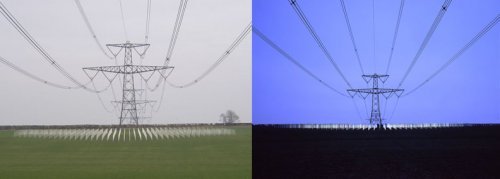In a world where color photographs are easy to come by it can be refreshing to stand back and look at images where the color has been simplified down to tones of black, white and gray.
Edwin Hale Lincoln (1848–1938) compiled his massive series, Wildflowers of New England, Photographed from Nature, in the early part of the 20th century. The photos are warm-toned platinum prints where the plants form decorative patterns. You can tell that the photographer was associated with the Arts and Crafts movement, and many of the photos could serve as templates for carved decorations on a piece of furniture.
 Left: Edwin Hale Lincoln. Convolvulus Septium, Hedge Bindweed, Morning-Glory, plate 124 from Wildflowers of New England, Photographed from Nature, Volume V, 1904. [ photo from the de Young Museum, which had an exhibition on Lincoln last year ]
Left: Edwin Hale Lincoln. Convolvulus Septium, Hedge Bindweed, Morning-Glory, plate 124 from Wildflowers of New England, Photographed from Nature, Volume V, 1904. [ photo from the de Young Museum, which had an exhibition on Lincoln last year ]
 Left: Edwin Hale Lincoln. Acorus Calamus, Flag-Root, Sweet Flag, Calamus-Root, 1914. [ image from Alan Klotz Gallery, which will be featuring Lincoln’s work in a show that runs from May 7th to July 2nd ]
Left: Edwin Hale Lincoln. Acorus Calamus, Flag-Root, Sweet Flag, Calamus-Root, 1914. [ image from Alan Klotz Gallery, which will be featuring Lincoln’s work in a show that runs from May 7th to July 2nd ]
Different from Lincoln’s work are the later photographs of Karl Blossfeldt (1865-1932). His 1928 Urformen der Kunst, published in the 1929 English edition, Art Forms in Nature, features 120 beautifully grainy photogravures. (Soulcatcher Studio has the entire volume online.) Blossfeldt followed up the book with a second volume in 1932.
Blossfeldt, like Lincoln, came out of an arts and crafts orientation, in his case, that of ornamental metalwork. But Blossfeldt moved in closer to his plants, often showing them in extreme magnification. He didn’t claim to be a scientist, and instead was looking at nature for the ultimate inspiration for human art.
(BTW, If you happen upon reruns of the TV show Will and Grace, take a look at Will’s apartment, and you’ll see several framed Blossfeldts prints on the set.)
Karl Blossfeldt. Sanguisorba, swallowwort, from Urformen der Kunst, 1928. [ image from the Wikimedia Commons ]
Karl Blossfeldt. Monkshood, from Urformen der Kunst, 1928. [ image from the Wikimedia Commons ]
But that’s barely scratching the surface. Check out Edward Weston’s stunning, almost lewd Cabbage Leaf. Or Imogen Cunningham’s Magnolia. Or one of Robert Mapplethorpe’s calla lilies.
Or next time you go out into your garden to photograph a plant, put your camera in black in white mode, and notice the things you start to pay attention to once the color isn’t there as a distraction…












 Larry and Debby Kline. Encryption (The Electric Fields of California, Site # 4) Sears Point Farming Company
Larry and Debby Kline. Encryption (The Electric Fields of California, Site # 4) Sears Point Farming Company [
[ 
















